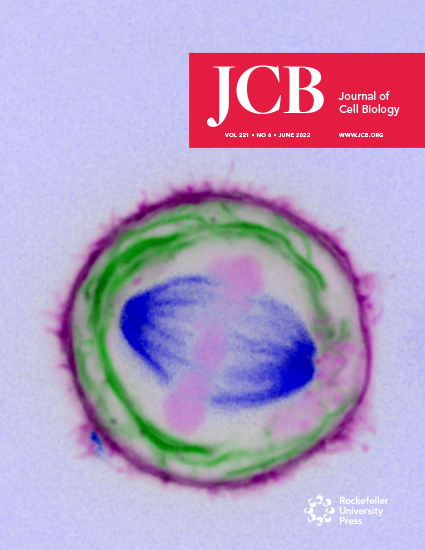- EN - English
- CN - 中文
3D Ultrastructural Visualization of Mitosis Fidelity in Human Cells Using Serial Block Face Scanning Electron Microscopy (SBF-SEM)
利用连续块面扫描电子显微镜(SBF-SEM)对人细胞有丝分裂保真度的三维超微结构可视化
发布: 2023年07月05日第13卷第13期 DOI: 10.21769/BioProtoc.4708 浏览次数: 1170
评审: Nafisa M. JadavjiAnonymous reviewer(s)
Abstract
Errors in chromosome segregation during mitosis lead to chromosome instability, resulting in an unbalanced number of chromosomes in the daughter cells. Light microscopy has been used extensively to study chromosome missegregation by visualizing errors of the mitotic spindle. However, less attention has been paid to understanding spindle function in the broader context of intracellular structures and organelles during mitosis. Here, we outline a protocol to visualize chromosomes and endomembranes in mitosis, combining light microscopy and 3D volume electron microscopy, serial block-face scanning electron microscopy (SBF-SEM). SBF-SEM provides high-resolution imaging of large volumes and subcellular structures, followed by image analysis and 3D reconstruction. This protocol allows scientists to visualize the whole subcellular context of the spindle during mitosis.
Keywords: Chromosome missegregation (染色体错离)Background
Cell division is essential for living organisms, as it is important for growth, repair, development, and reproduction. Accurate chromosome segregation during mitosis is essential to maintain genomic stability in cell division. Entry into mitosis involves a dramatic, large scale cellular reorganization. After the nuclear envelope breaks down, the chromosomes congress at the cell equator. The mitotic spindle, a complex subcellular machine, coordinates this congression and then the accurate segregation of sister chromatids to the two daughter cells. The combination of light and electron microscopy (EM), together with computer-based 3D reconstruction, shows that the mitotic spindle is localized in an exclusion zone, which is free of endomembranes: nuclear envelope and Golgi remnants, endoplasmic reticulum (ER), and vesicles (Puhka et al., 2007; Lu et al., 2009; Puhka et al., 2012; Champion et al., 2017; Nixon et al., 2017). Beyond the exclusion zone, the endomembranes are densely packed and mitochondria are randomly distributed. Recently, we described how chromosomes that do not congress to the cell equator can lie beyond the exclusion zone and become ensheathed by endomembranes, constituting a risk factor for chromosome instability (Ferrandiz et al., 2022). Our aim here is to provide a detailed step-by-step protocol to visualize, at the ultrastructural level, these chromosomes that become ensheathed by endomembranes. We use light microscopy to locate the cell of interest and then semi-automated large volume EM method (serial block-face scanning electron microscopy, SBF-EM) and 3D reconstruction to visualize the mitotic cell. The protocol will be useful for other applications where the total endomembrane content of mitotic cells, or indeed non-dividing cells, needs to be visualized.
Materials and reagents
Cell culture
DMEM/F-12 Ham (Merck Life Science, catalog number: D6421-6)
Fetal bovine serum (FBS) (Sigma, catalog number: F7524)
Trypsin-EDTA solution (Sigma, catalog number: T3924)
l-glutamine (Sigma, catalog number: G7513)
Penicillin/streptomycin (Gibco, catalog number: 15140-122)
Sodium bicarbonate (NaHCO3) (Sigma, catalog number: D8662)
MatTek gridded glass-bottom culture dishes (MatTek Corporation, catalog number: P35G-1.5-14-CGRD)
Fugene HD transfection reagent (Promega, catalog number: E2312)
OptiMEM (Gibco, catalog number: 10149832)
GSK923295 (Selleckchem, catalog number: s7090)
Thymidine (Sigma, catalog number: T1895)
RO-3306 (Sigma-Aldrich, catalog number: SML0569)
SiR-DNA (Spirochrome, catalog number: SC007)
Poly-L-Lysine (Sigma-Aldrich, catalog number: P8920)
Concanavalin A (Sigma-Aldrich, catalog number: C2010)
Sample processing
Sodium phosphate dibasic (Na2HPO4) (Sigma, catalog number: S0876)
Sodium phosphate monobasic (Na HPO4) (Sigma, catalog number: S0751)
Potassium hydroxide (KOH) (Sigma, catalog number: 221473)
Glutaraldehyde 25% (Agar, catalog number: R1011)
Paraformaldehyde 16% (Thermo Fisher, catalog number: 28908)
Tannic acid, low molecular weight (Electronic Microscopy Science, catalog number: 21710)
OsO4 (TABB, catalog number: O014)
Potassium ferrocyanide (Sigma, catalog number: 14459-95-1)
Thiocarbohydrazide (TABB, catalog number: T009)
Uranyl acetate (UA) (TAAB, catalog number: U008)
Methanol anhydrous (Sigma, catalog number: 322415)
Lead nitrate (TAAB, catalog number: L019)
l-Aspartic acid (Sigma, catalog number: A9256)
Ethanol molecular grade (Sigma, catalog number: 51976)
Agar 100 premix kit-Hard (Agar Scientific, catalog number: R1140)
Silver conductive paste (TAAB, catalog number: S384)
Gold/Palladium (80/20%) 60 mm × 0.1 mm (Quorum technologies, catalog number: SC500-314B)
0.1 M phosphate buffered (PB) saline (see Recipes)
Fixation buffer (see Recipes)
2% reduced osmium (see Recipes)
1% thiocarbohydrazide (TCH) solution (see Recipes)
1% uranyl acetate (UA) (see Recipes)
Lead aspartate solution (see Recipes)
Agar 100 premix kit (see Recipes)
Equipment
Nikon CSU-W1 spinning disc confocal system with SoRa upgrade (Yokogawa). Used with a Nikon, 20×/0.50 objective (Nikon) with optional 2.3× intermediate magnification or 60×, 1.40 NA, oil, Plan Apo VC objective (Nikon), and 95B Prime camera (Photometrics). The system has CSU-W1 (Yokogawa) spinning disk unit with 50 μm and SoRa disks (SoRa disk used), Nikon Perfect Focus autofocus, Okolab microscope incubator, Nikon motorized XY stage, and Nikon 200 μm z-piezo. Excitation was via 405, 488, 561, and 638 nm lasers with 405/488/561/640 nm dichroic and Blue, 446/60; Green, 525/50; Red, 600/52; FRed, 708/75 emission filters
Ultramicrotome (Leica Microsystems, EM UC7)
Gatan 3 View system installed on an FEI Quant 250 ESEM, with digital micrograph software (Gatan)
Software
NiS Elements (Nikon)
Digital micrograph software (Gatan)
Open-source programs for analyzing images such as:
Fiji (https://fiji.sc) (version 2.9.0)
Microscopy Image Browser (http://mib.helsinki.fi) (version 2.60)
IMOD (https://bio3d.colorado.edu/imod/) (version 4.10.49)
Procedure
文章信息
版权信息
© 2023 The Author(s); This is an open access article under the CC BY license (https://creativecommons.org/licenses/by/4.0/).
如何引用
Readers should cite both the Bio-protocol article and the original research article where this protocol was used:
- Ferrandiz, N. and Royle, S. J. (2023). 3D Ultrastructural Visualization of Mitosis Fidelity in Human Cells Using Serial Block Face Scanning Electron Microscopy (SBF-SEM). Bio-protocol 13(13): e4708. DOI: 10.21769/BioProtoc.4708.
- Ferrandiz, N., Downie, L., Starling, G. P. and Royle, S. J. (2022). Endomembranes promote chromosome missegregation by ensheathing misaligned chromosomes. J Cell Biol 221(6): e202203021.
分类
癌症生物学 > 基因组不稳定性及突变 > 细胞生物学试验
细胞生物学 > 细胞成像 > 活细胞成像
您对这篇实验方法有问题吗?
在此处发布您的问题,我们将邀请本文作者来回答。同时,我们会将您的问题发布到Bio-protocol Exchange,以便寻求社区成员的帮助。
提问指南
+ 问题描述
写下详细的问题描述,包括所有有助于他人回答您问题的信息(例如实验过程、条件和相关图像等)。
Share
Bluesky
X
Copy link












